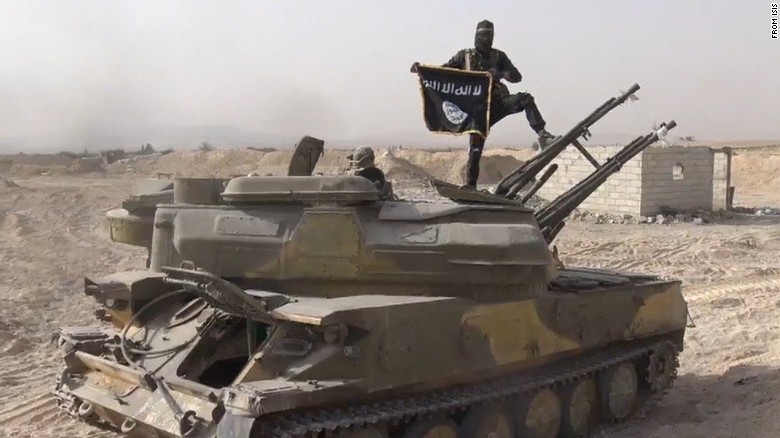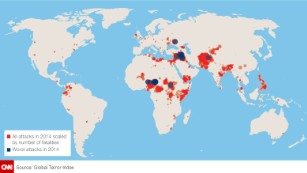
The deadly terror attacks in Paris and Beirut last week are consistent with a worldwide trend of increased terrorism — now at its highest level ever — according to a new study.
Deaths from global terrorism increased by 80% in 2014 with 32,658 people being killed, says the study.
The report highlights that despite 78% of terrorist acts being concentrated in five countries — Pakistan, Nigeria, Afghanistan, Syria and Iraq — terrorism is spreading, with more countries recording attacks and deaths than previously.
The Global Terrorism Index report, which was released Tuesday, says there has been a “dramatic rise” in terrorism over the last 15 years. There are nine times more people killed in terrorist attacks today than there were in 2000.
Islamist groups Boko Haram and ISIS together were responsible for 51% of claimed global killings in 2014.
Where is it happening?
Iraq continues to be the country most impacted by terrorism, with 9,929 terrorist fatalities last year, the highest ever recorded in a single country.
Nigeria had the biggest year-on-year increase ever recorded with 7,512 deaths in 2014, up over 300% since 2013.
The number of countries experiencing more than 500 terrorism deaths increased from five to eleven in 2013. The six new countries to the list are Somalia, Ukraine, Yemen, Central African Republic, South Sudan and Cameroon. The report adds that Ukraine entered the list due to the downing of Malaysia Airlines flight MH17 by a missile in a rebel-controlled area in the east of the country, killing all 289 people on board.
Most deaths from terrorism are not taking place in the West. Excluding the 9/11 attacks, since 2000 only 0.5% of deaths from terrorism have occurred on Western soil.
The number of countries experiencing more than 500 terrorism deaths increased from five to eleven in 2013. The six new countries to the list are Somalia, Ukraine, Yemen, Central African Republic, South Sudan and Cameroon. The report adds that Ukraine entered the list due to the downing of Malaysia Airlines flight MH17 by a missile in a rebel-controlled area in the east of the country, killing all 289 people on board.
Most deaths from terrorism are not taking place in the West. Excluding the 9/11 attacks, since 2000 only 0.5% of deaths from terrorism have occurred on Western soil.
Of the attacks that did take place in the West, “lone wolf” attackers are the main perpetrators — causing 70% of all deaths since 2006.
The majority of “lone wolf” attackers are a mixture political extremists, nationalists, racial, religious and white supremacists and, to a lesser degree, Islamic fundamentalists.
Economic impact
The report, which was compiled using data from the University of Maryland, says the global economic cost of terrorism last year reached an all-time high of $52.9 billion.
This cost was 61% higher than 2013, when the economic cost of terrorism reached $32.9 billion, and over a tenfold increase since 2000. The vast majority of the costs stem from injury and death.
“Terrorist activity is a significant driver of forced migration,” cites the report. “Ten of the 11 countries most affected by terrorism also have the highest rates of refugees and internal displacement. This highlights the strong connection between the current refugee crisis, terrorism and conflict.”
What is driving terrorism?
Political violence and conflict are the two factors most closely linked to terrorism.
Between 1989 and 2014, 92% of all terrorist attacks took place in countries where state-funded political violence was widespread.
Drivers of terrorism differ however. In developed countries, socioeconomic factors such as lack of opportunity and low social cohesion are significantly linked to terrorism. In less-developed countries, internal conflicts, political terror, and corruption are strongly linked to terrorism.
Since there are clear sociopolitical factors that foster terrorism, it is important to implement policies addressing these associated causes, said Steve Killelea, founder of the Institute for Economics and Peace. “This includes reducing state-sponsored violence, diffusing group grievances, and improving respect for human rights and religious freedoms, while considering cultural nuances,” wrote Killelea.
The rise of ISIS has been significant. The flow of foreign fighters into Iraq and Syria since 2011 is the largest influx in modern times, with current estimates now ranging from 25,000 to 30,000 fighters from 100 countries. This flow of foreign fighters does not appear to be diminishing, the report says, with over 7,000 arriving in the first six months of 2015 alone.
Homicides are still deadlier
While terrorism is undoubtedly a major concern for safety and security, the report also highlights the fact that global homicide accounts for more deaths annually than terrorism.
The global homicide rate is 13 times the global terrorism rate, with 437,000 people dying from homicides compared to 32,685 from terrorism in 2014.
The deadliest city in the world for terrorism is Baghdad. There were 2,454 deaths in Baghdad in 2014, with a death rate from terrorism of 43 per 100,000 people.
Many cities in the world have higher homicide rates than the highest terrorist rates. Caracas, for example, holds the highest homicide rate in the world at 111 per 100,000 for the decade starting from 2000.
As reported by CNN

